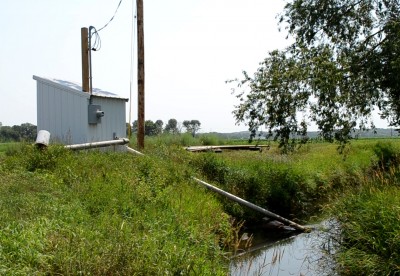Oct 5, 2017Farm conservation practices touted in Western Lake Erie Basin
Voluntary conservation practices adopted by farmers in the Western Lake Erie Basin are having positive impacts downstream, according to a new report from the U.S. Department of Agriculture (USDA). This report by USDA’s Conservation Effects Assessment Project (CEAP) shows these practices reduce sediment losses from fields by an estimated 80 percent and reduce the amount of sediment being delivered to Lake Erie by an estimated 40 percent.
“One thing I know for certain – the benefits of conservation flow downstream,” said Leonard Jordan, acting chief of USDA’s Natural Resources Conservation Service (NRCS). “When hundreds of farms take action in one area, one watershed, it can make a world of difference. And our conservation planning and financial support provides producers a step-by-step plan to achieve those results.”
NRCS helps farmers make conservation improvements on working lands. Reports like this one help the agency better understand the effectiveness of conservation practices and how to adapt conservation approaches, Jordan said. Though there is still work to be done, this report shows that private land owners are responding to regional needs and putting conservation plans into action to improve water quality across the basin.
This is the second of a two-part report on the Western Lake Erie basin, which has historically suffered from high levels of nutrients and sediment associated with human activities in the region. The first report focused on edge-of-field losses, whereas this report focuses on sediment and nutrients entering streams, rivers and Lake Erie.
Relative to the scenario where no agricultural conservation practices were in place, the voluntary conservation practices in use by farmers in the basin in 2012:
- Reduce phosphorus and nitrogen lost from cultivated cropland fields by 61 and 26 percent, respectively;
- Reduce phosphorus and nitrogen deposition into the streams and rivers of the lake’s basin by 72 and 37 percent, respectively; and
- Reduce phosphorus and nitrogen entering the lake by 41 and 17 percent, respectively.
Water quality is directly impacted by nutrients and sediment. By reducing the amount of nitrogen and phosphorus entering basin waterways, farmers are doing their part to reduce the chances of harmful algal blooms that may lead to hypoxia, or oxygen depletion, throughout the lake. Algal blooms can make the lake unsuitable as a source of drinking water and recreation as well as habitat for fish and wildlife.
CEAP uses a sampling and modeling technique to yield these results, quantifying the impacts of conservation practices adopted across the region. These analyses provide scientifically-based direction for future conservation planning efforts targeting specific management goals.
Farmers use a variety of conservation practices to reduce losses of nutrients and sediment. The practices evaluated by CEAP include strategies like nutrient management, cover crops and structural erosion control. Cutting-edge technologies that use GPS and variable rate applications are also assessed.
While many Western Lake Erie basin producers have worked independently to curb agricultural runoff into the Great Lakes system over the past 50 years, recent Farm Bill programs have accelerated conservation efforts on private lands located in targeted watersheds throughout the region. Coordinated and targeted efforts through the Western Lake Erie Basin Initiative, Great Lakes Restoration Initiative, National Water Quality Initiative and Regional Conservation Partnership Program provide additional funding and leverage partnerships in priority watersheds, including those that flow into the Western Lake Erie basin.
“Conservation applied on any acre delivers an environmental benefit, but when conservation efforts target the most vulnerable watersheds and lands, the results are even greater,” added Jordan. “We know it won’t solve the problem alone, but it’s a critical piece of the broader solution.”
The effectiveness of targeted conservation planning is also assessed in the report. These results and other CEAP assessments in the region provide another source for informing science-based conservation efforts within the basin. Upcoming assessments will continue to build upon this base.
Read the full report, titled Conservation Practice Adoption on Cultivated Cropland Acres: Effects on Instream Nutrient and Sediment Dynamics and Delivery in Western Lake Erie Basin, 2003-06 and 2012.

















